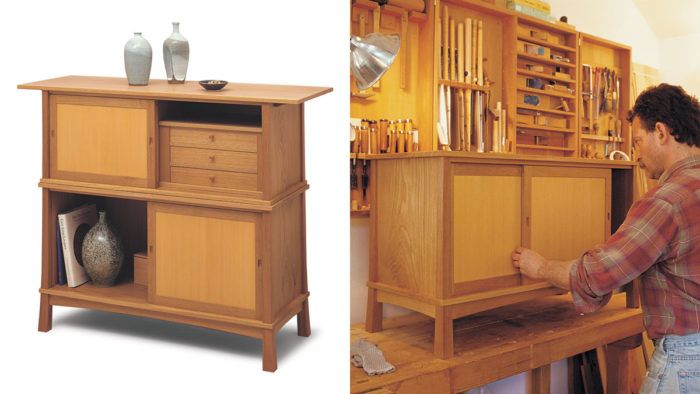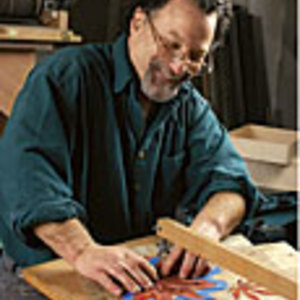Component-Built Sideboard
Separate assemblies make construction manageable, and careful detailing produces a unified design
Synopsis: Seth Janofsky explains the design and construction of a sideboard, in this article with detailed project plans. In addition to project plans, Janofsky’s explains of how to install a sliding doors and drawer box with illustrated detailed drawings and photos. The sideboard is unique in that it consists of two boxes with the legs and sides made as a unit. The base of the piece is screwed to the underside of the lower case, and he bandsawed an arch on the bottom edge of the rails to make it link visually with the upper case. Included are tips on prefinishing parts before glue up.
I work alone in a very small shop. Actually, in two small shops. My machines rub elbows in a cramped basement room, while my workbench and hand tools are up on the first floor in another small room. The two shops are not connected by a stair, and getting from the machines to the workbench requires a walk outside, uphill around the house. So one of the things I try to do when making furniture is design for efficient construction, breaking things down into subassemblies that I can handle easily in my small space and work on comfortably by myself. I also like the finished pieces of furniture to be as easy to handle, pack and move as possible. I’ve developed ways of designing that take these things into account while still aiming to produce striking, useful pieces. The white oak sideboard I recently completed is a good example of the way I design to accommodate these various needs while bringing unity to a piece that, when finished, remains essentially a stack of separate components.
Design time: compromise begets good furniture
As odd as it may sound at first, I think the finest furniture is the result of a lot of compromise. Not the kind of compromise that leads to cutting corners and doing less than the best possible work, but rather the compromise that’s involved when you strive to balance three things: the aesthetic needs of a piece, the requirements of function, and construction that is sound and efficient. There should be a back-and-forth between aesthetics, function and construction during the design process; the craftsman has to see to it that all three purposes are well served and that none of the three dominates at the expense of the others. With skill and conscientious effort, and a little luck, the end result will be a piece of furniture that sits, as it were, at the best possible balance point of these three demands.
When I set out to make this sideboard, I had a number of considerations in mind. In terms of function, I wanted a useful piece with a serving surface, compartments for dishes, probably with some adjustable shelves, and drawers for silverware. I didn’t want a piece that was limited to use as a sideboard, however. I wanted one that could also function as a display cabinet for pottery or for other decorative objects. Aesthetically, I had in mind something light and delicate looking, even as it was strong and durable. Nothing flamboyant but rather a quiet, refined kind of thing. As for the specific style, I explored in the general direction of other cabinets I’ve made, which blend traditional Japanese and Scandinavian-modern influences. In terms of construction, I wanted solid, straightforward joinery—structurally sound, efficient to make, subjugated to the quiet design I envisioned.
From Fine Woodworking #137
For the full article, download the PDF below:
Fine Woodworking Recommended Products

Bessey EKH Trigger Clamps

Drafting Tools

Sketchup Class






















Log in or create an account to post a comment.
Sign up Log in